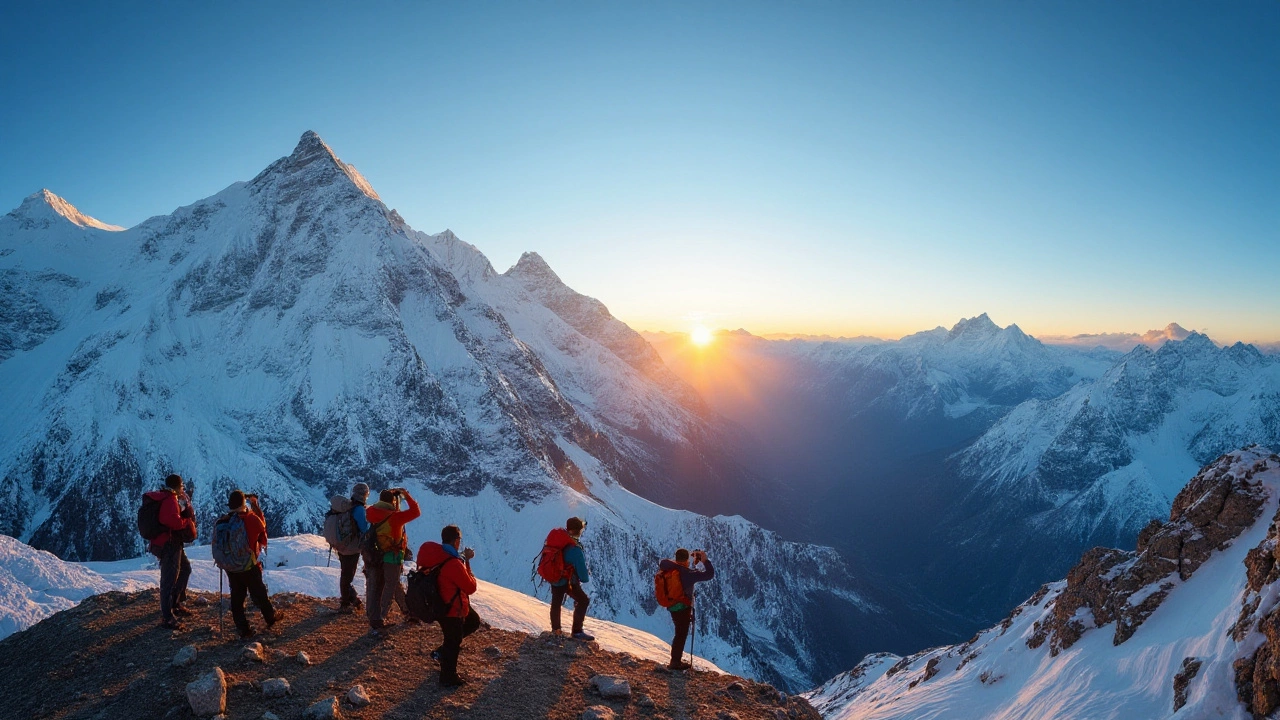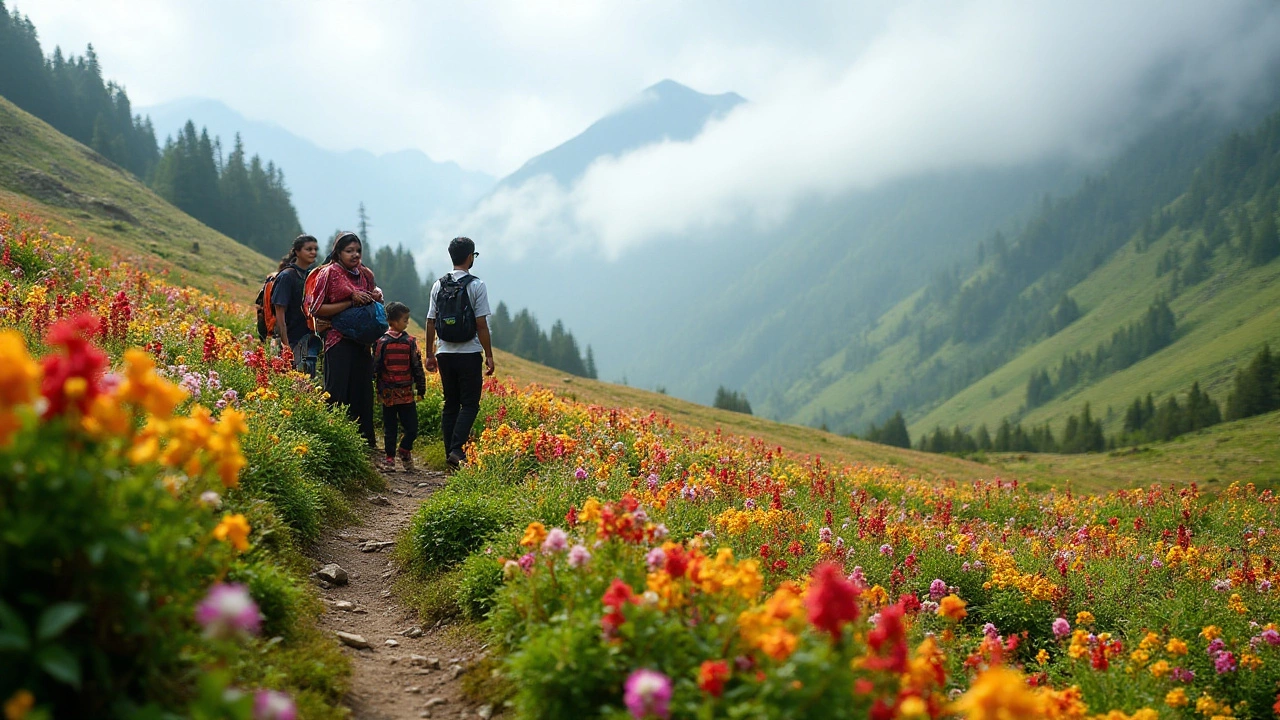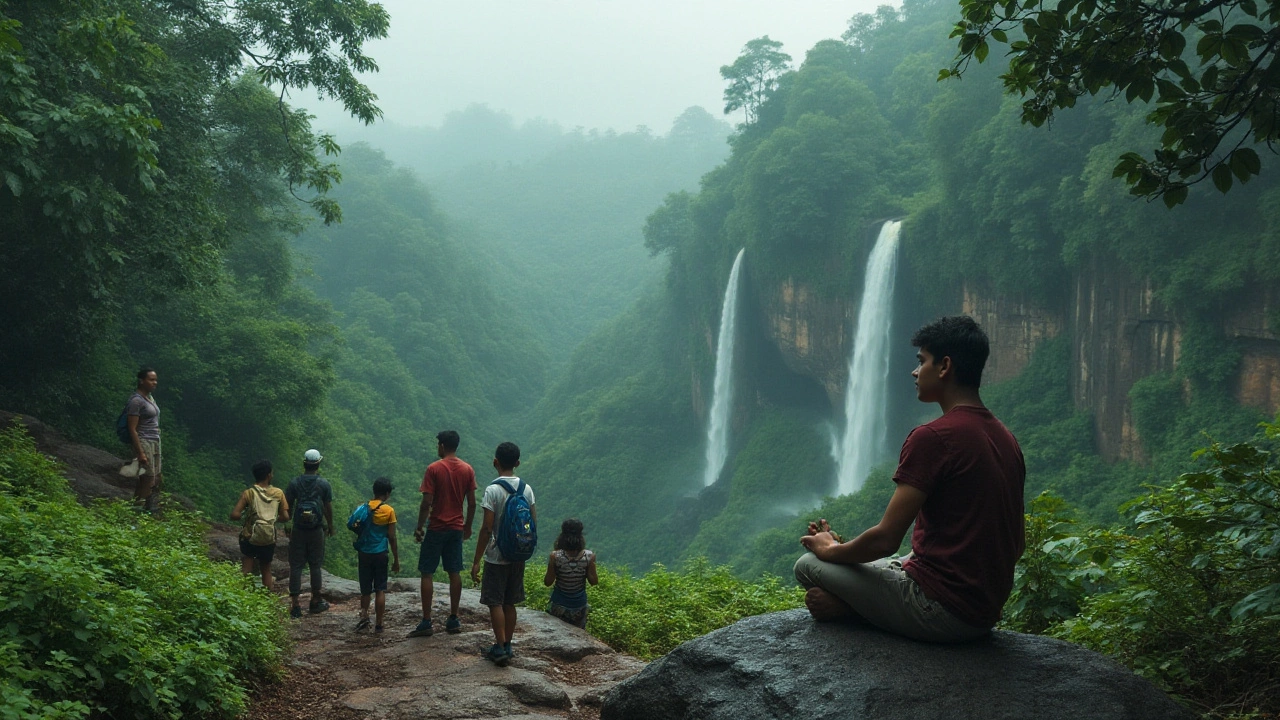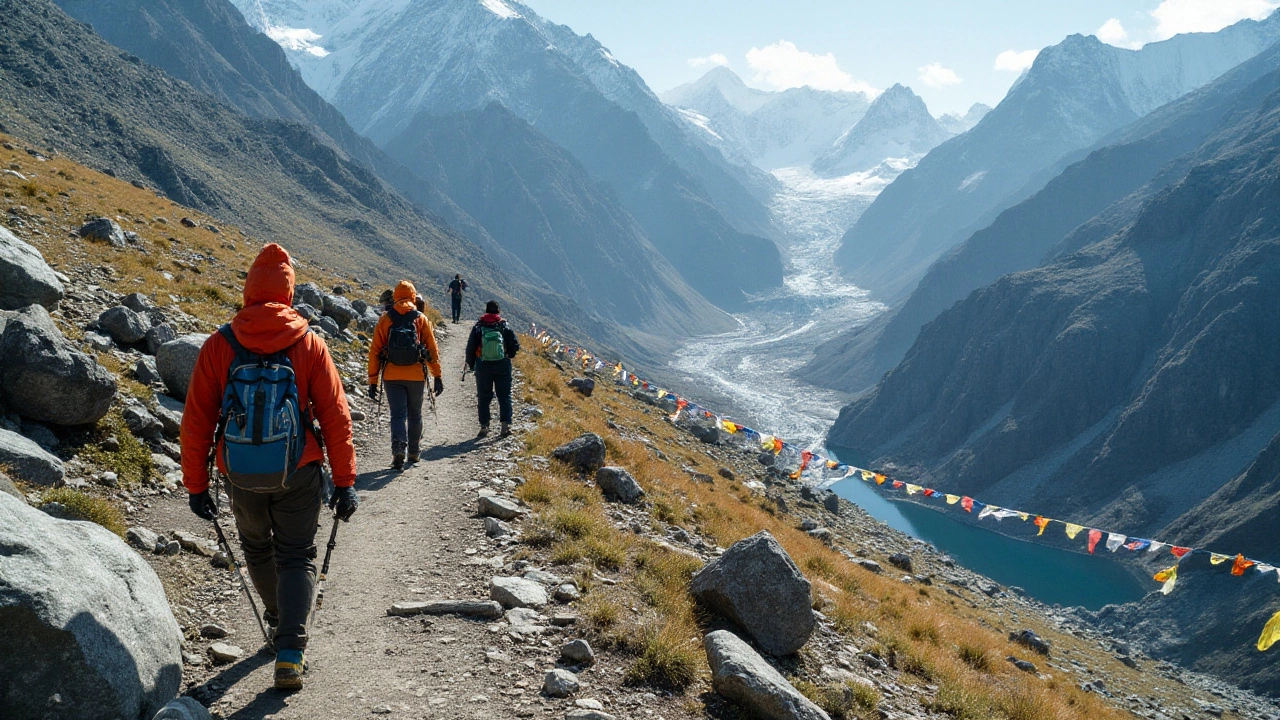Top Trekking Destinations in India for Enthusiastic Hikers
 Jan, 10 2025
Jan, 10 2025
India is a marvel for those passionate about hiking. Its varied landscapes offer trails and routes that cater to everyone, from the seasoned trekker to the casual wandering enthusiast. The country's vibrant tapestry of cultures, breathtaking scenic vistas, and rich biodiversity ensure that every trail offers more than just a physical challenge. Each hike becomes an opportunity to immerse in stories, experience traditions, and connect deeply with nature.
For those with a penchant for high altitudes, the Himalayas stand as the undisputed champion of trekking adventures. These treks test resilience and reward with mesmerizing views and a serene escape from the bustle of modern life. Meanwhile, the Western Ghats offer alluring trails where the air is filled with the intoxicating scent of moist earth, thriving wildlife, and cascading waterfalls.
Not all adventures need steep climbs or remote locations. For some, the joy of hiking comes from walking paths charted through the historical and cultural heartlands of India. Trails that traverse beautiful landscapes and weave in stories of times gone by, enriched by encounters with warm and welcoming locals.
Whether you're an experienced hiker or setting off on your first trek, India has something to offer to ignite your spirit of adventure. Each trek offers its own unique journey, a chance to step away from the mundane and embark on something truly extraordinary.
- Himalayan Treks for the Adventurous Soul
- Exploring the Scenic Trails of the Western Ghats
- Cultural Hikes in the Indian Heartland
- Essential Tips for Trekking in India
Himalayan Treks for the Adventurous Soul
When it comes to trekking, the Himalayas are often seen as the holy grail for adventurous souls. The towering peaks, mysterious valleys, and snow-clad landscapes offer trails that are as daunting as they are breathtakingly beautiful. Far more than just a physical challenge, each trek in the Himalayas is a journey into the heart of the world's mightiest mountain range. Trails like the Chadar Trek, which takes trekkers over the frozen Zanskar River, or the arduous climb to the base camp of Mount Everest, test one's endurance and ignite a sense of awe. The Roopkund Trek is another intriguing destination, challenging adventurers with a rugged path that meanders through dense forests and ends at a glacial lake surrounded by ancient human skeletons. Known as the 'Skeleton Lake,' Roopkund adds an eerie yet fascinating twist to the trekking experience.
Among the most well-trodden paths is the Markha Valley Trek, renowned for its vibrant landscapes and rich cultural heritage. Situated in Ladakh, this trek offers participants an exhilarating mix of heart-pounding adventure and tranquil beauty. The trail interweaves through quaint villages, where the smiling locals offer an insight into their simple yet fulfilling lives. The kindness of strangers, combined with the stark beauty of the barren landscape, often leaves a lasting imprint on trekkers' hearts.
"The mountains are calling, and I must go." — John Muir.So said Muir, yet many who travel these paths are discovering something even deeper: a call to understand and appreciate the delicate interplay of nature and survival in these high altitudes.
For those yearning more than just high-altitude trekking, the Himachal Pradesh region presents exceptional routes that blend both adventure and scenery. The Hampta Pass trek is a prime example, bridging the lush green valleys of Kullu with the stark landscapes of Spiti. Trekkers are treated to diverse terrains, from grassy meadows to barren lands, and the adrenaline rush from crossing the high mountain pass itself. Moving to the northeast, Sikkim offers the Goecha La Trek, where the view of Kanchenjunga at sunrise is worth every grueling step taken up the rugged path. This specific hike is intimate, requiring smaller groups to maintain the tranquility and balance of the region’s ecosystem.
Trekking in the Himalayas is not just a solitary adventure; it requires careful preparation, the right attitude, and a spirit of respect for the mountains. Seasoned trekkers often say it's not the mountain we conquer, but ourselves. As harsh and challenging as these environments can be, they offer invaluable lessons in humility, patience, and resilience. Each step taken on these mystical trails is a testament to human will, a celebration of nature’s grandeur, and a call to adventure for all those who dare.

Exploring the Scenic Trails of the Western Ghats
The Western Ghats, a UNESCO World Heritage site, is a treasure trove of lush greenery and biodiversity that beckons hikers with its enchanting landscapes. Spanning across several Indian states like Maharashtra, Karnataka, Tamil Nadu, Kerala, and Goa, this mountain range is a thriving ecosystem teeming with vibrant wildlife, rare flora, and breathtaking waterfalls. For adventurers, the Western Ghats offer an extensive array of trails that cater to every preference and skill level, making it a perfect destination for those who seek the beauty of nature intertwined with the thrill of hiking trails India.
Among the standout trails is the Kumaraparvatha trek in Karnataka, which is famed for its rugged terrain and panoramic views. While demanding due to its steep inclines, the trail rewards hikers with the invigorating sight of the Pushpagiri Wildlife Sanctuary and the chance to witness the clouds lifting from the peaks like a mystical veil. Not far behind in allure is Chembra Peak trek in Kerala, an expedition that culminates in a heart-shaped lake that has captivated the imagination of many. The tranquility and serenity of this spot attract travelers seeking a peaceful retreat amid nature's splendor.
Also notable is the Mullayanagiri trek, which claims the title of the highest peak in Karnataka. The path is steeped in history, letting hikers explore Shrines that echo tales of old. As you ascend, you're accompanied by gentle breezes that carry the songs of birdlife, and if you're lucky, a sight of the rare Nilgiri Tahr. A unique feature of the Western Ghats is the monsoon-fed waterfalls, with Dudhsagar Falls being particularly impressive. Standing before the cascading waters, you realize why this region has retained its charm through centuries. Its pristine state is a testimony to minimal human interference and the dedication to conservation efforts.
The Western Ghats are crucial to our planet's biodiversity, not just for their beauty but for their untapped potential in offering new insights into species' evolution.” - Conservation International
For those seeking a different yet rewarding trek, the Agasthyarkoodam offers an exhilarating experience. Located in Kerala, this trek is a blend of myth and reality, named after the sage Agastya, believed to inhabit these mountains. The path snakes through forested realms and has specific sections that are only open to trekkers during certain months, preserving its ecosystems' delicate balance. To navigate these trails, the ideal time to visit the Western Ghats is between October and February, when the climate remains temperate, and nature exhibits her most vibrant hues.
Before you embark, ensure you're well-prepared with suitable gear, adequate hydration supplies, and knowledge of the trail's difficulty level. Remember, each path presents a chance to not only witness the astounding beauty but to become a guardian of these landscapes. Treading lightly and respectfully ensures that future generations can also enjoy the awe-inspiring beauty of the Western Ghats.

Cultural Hikes in the Indian Heartland
Trekking in India is not just about the physical journey through its rugged terrains but also about diving deep into its cultural wealth. The heartlands of India, often overshadowed by the grandeur of its mountainous and coastal areas, hold stories and traditions of equal intrigue and value. These regions offer unique hiking trails where every step traverses paths laden with history, cultural nuances, and an atmosphere that evokes the feeling of traveling back in time.
One such enchanting destination is the ancient town of Hampi located in Karnataka. Known for its ruined temple complexes and the captivating landscape dotted with boulders of varying shapes and sizes, Hampi offers hikes that take you through the remnants of the Vijayanagara Empire. This is a place where solitude meets history, inviting hikers to ponder over the remnants of past civilizations. Its rocky paths and climbs beckon those who wish to reflect upon the unsaid stories of the artisans and architects who once traversed these lands. A stone's throw from the active bazaar area, the trails often open up to stunning vistas of the Tungabhadra River, reminding one of the vastness of time and the little space we occupy in its long run.
"Walking through Hampi is like turning the pages of a history book, each temple and monument a story waiting to be told," shared renowned travel writer Aparna Raj, capturing the essence of the place perfectly.
Meanwhile, in the north-central region of India, a mystical trek awaits in the Aravalli Range. Here, one can explore the trails around the holy city of Pushkar, Rajasthan. This region, though arid, surprises hikers with its hidden charms. The Nag Pahad, or Snake Mountain, offers a serene trek with a panoramic view of the sacred Pushkar Lake and its temples peeking through amidst a sea of sands. As you make your way up, the rustic aroma of the earth combined with the distant chants from town below provides an overwhelming sensory tapestry. In the month of Kartika (November), the hills come alive with devotees and visitors embarking on this cultural trek to witness the famed Pushkar Camel Fair, a spectacle of vibrant traditions and colorful art forms.
Delving into Tribal Cultures
No exploration of India’s cultural heartland would be complete without venturing into the trails graced by the indigenous tribes of Orissa and Chhattisgarh. These paths, much like veins through the heart, offer insights into a way of life that has remained relatively unchanged for centuries. The lush green landscape of the Eastern Ghats or the deep forests of Bastar guide hikers into the heart of tribal culture. Exploring Niyamgiri Hills or the Kanger Valley trails takes trekkers not just through mesmerizing natural beauty but through stories and lifestyles of tribes like the Kondhs and Gonds. These hikes offer the profound experience of cultural immersion, blending the challenge of trekking with the warmth of human interaction. Under canopies of dense forests, visitors often stumble upon small settlements where hospitality is offered with a genuine smile and shared tales of folklore and rich heritage - a journey where nature and man harmonize in a grand story.
The diverse and enriching experiences found on Indian trek routes continue to captivate adventurers. While the challenge of the hike tests physical limits, it's the deeper cultural interaction and connection with the land that ultimately leaves an indelible mark in the heart of every traveler. The Indian heartland, with its hidden gems and rich tapestry of traditions, transforms a trekker into a storyteller, weaving personal narratives into the larger fabric of India's vast history.

Essential Tips for Trekking in India
Trekking in India is full of surprises and requires a thoughtful approach to ensure a memorable experience. The terrain can be as demanding as it is rewarding, and adequate preparation is key. A significant starting point is choosing the right season for your trek. The diverse Indian landscape means that weather can vary drastically depending on your location. For Himalayan treks, April to June and September to November offer comfortable conditions, while the Western Ghats are best explored right after the monsoon until early March when the greenery is vibrant and waterfalls spectacular.
Hydration is another cornerstone of a successful trek. Carry more water than you think you'll need. Dehydration can sneak up quickly, especially at higher altitudes. Familiarize yourself with natural water sources along the trail if possible and use purification tablets to ensure cleanliness. Nutrition, too, plays a pivotal role. Snack regularly on energy-rich foods to maintain stamina. Hiking trails in India can range from leisurely walks to climbs requiring significant endurance, and skipping meals can have unpleasant consequences on your energy levels.
Investing in quality gear cannot be overstated, considering India’s varying weather patterns. Breathable clothing is essential to handle both humidity and chill, while a sturdy pair of trekking boots can make all the difference. Pack efficiently; each item should serve a purpose, from quick-dry apparel to first aid supplies. A waterproof backpack cover will save you during untimely showers that are frequent in many regions. It’s also wise to hike with a companion or inform someone of your trekking plans, especially if venturing into isolated areas.
Respect local customs and environments. Indian trails often weave through villages where traditions are deeply rooted. Being courteous opens doors to enriched cultural exchanges. As unforeseen adventures are part of the charm, patience can become your greatest ally. Socially, trekkers have a responsibility to preserve trails. Carry all waste back with you, and discourage littering to maintain the pristine beauty of these sites. The smallest efforts contribute significantly to sustainable trekking.
Finally, acclimatization shouldn’t be ignored, particularly during Himalayan treks. Ascend gradually and allot time to adjust at altitude. Acute mountain sickness is a real risk and attempting a climb too quickly could lead to serious health issues. Pay attention to your body’s signals, and never hesitate to rest if needed. This thoughtful approach allows you to fully enjoy the awe-inspiring beauty of Indian trek routes at your own pace.
‘Climb the mountains and get their good tidings, nature’s peace will flow into you as sunshine flows into trees,’ wisely noted John Muir, highlighting the rejuvenating power of nature.